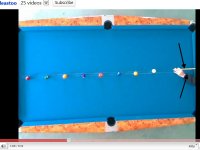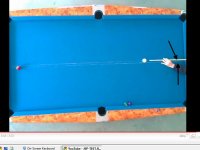For the purpose of the discussion we should probably have some definitions.
I propose the following.
Sighting: The line by which the shooter initially aligns themselves to the postion of the balls.
Alignment: The position of the body in relation to the cueball.
Center (Sighting): The physical center of the cueball or object ball as seen from the top of the ball or the bottom where it sits on the table.
Center (Pivoting): The center of the cue ball as seen when addressing the cueball.
Aiming Line: the actual line which the cue ball will travel on when struck at center ball.
Pivoting: The act of turning the cue into the aiming line as opposed to laying the cue down on the aiming line. ex: when lining up a straight in shot the shooter can lay the cue straight down on the aiming line which extends through both centers and the bridge. When using a pivot system the shooter would pivot the cue to center ball and put the bridge hand down along the aiming line produced by the system.
Pivot Point: The point around which the cue rotates while the shooter is pivoting it into position.
Edge: The visible outermost point of the ball. Note - the visible edge changes with body and head position.
Center to Edge Line (CTEL): The line produced by sighting the Center of the cueball to the Edge of the object ball.
_________________________________________________________
Feel free to add to this glossary of terms.
I propose the following.
Sighting: The line by which the shooter initially aligns themselves to the postion of the balls.
Alignment: The position of the body in relation to the cueball.
Center (Sighting): The physical center of the cueball or object ball as seen from the top of the ball or the bottom where it sits on the table.
Center (Pivoting): The center of the cue ball as seen when addressing the cueball.
Aiming Line: the actual line which the cue ball will travel on when struck at center ball.
Pivoting: The act of turning the cue into the aiming line as opposed to laying the cue down on the aiming line. ex: when lining up a straight in shot the shooter can lay the cue straight down on the aiming line which extends through both centers and the bridge. When using a pivot system the shooter would pivot the cue to center ball and put the bridge hand down along the aiming line produced by the system.
Pivot Point: The point around which the cue rotates while the shooter is pivoting it into position.
Edge: The visible outermost point of the ball. Note - the visible edge changes with body and head position.
Center to Edge Line (CTEL): The line produced by sighting the Center of the cueball to the Edge of the object ball.
_________________________________________________________
Feel free to add to this glossary of terms.


